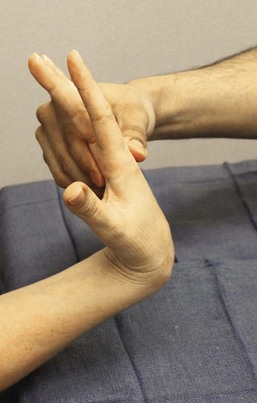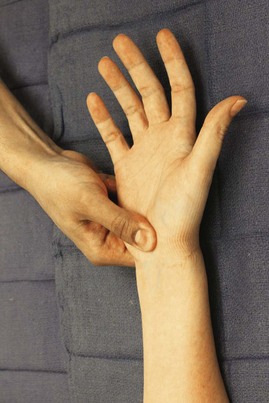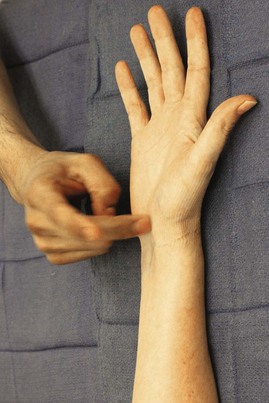Procedure 12 Open Carpal Tunnel Release
![]() See Video 10: Open Carpal Tunnel Release
See Video 10: Open Carpal Tunnel Release
Indications
 Diagnosis of carpal tunnel syndrome with one of the following:
Diagnosis of carpal tunnel syndrome with one of the following:
Examination/Imaging
Clinical Examination
 Phalen test (Fig. 12-1): The patient’s wrist is held in a flexed position for up to 1 minute or until onset of symptoms. A positive test consists of the onset of numbness or paraesthesia in the median nerve distribution. Care must be taken to avoid direct pressure or flexion at the elbow when performing this examination, in order to avoid inducing ulnar nerve symptoms.
Phalen test (Fig. 12-1): The patient’s wrist is held in a flexed position for up to 1 minute or until onset of symptoms. A positive test consists of the onset of numbness or paraesthesia in the median nerve distribution. Care must be taken to avoid direct pressure or flexion at the elbow when performing this examination, in order to avoid inducing ulnar nerve symptoms.
 Carpal tunnel compression test (Fig. 12-2): The examiner applies direct pressure to the carpal tunnel with his or her thumb for up to 1 minute or until onset of symptoms. A positive test consists of the onset of numbness or paresthesia in the median nerve distribution. As with Phalen test, care is taken to avoid direct pressure or flexion at the elbow when performing this examination.
Carpal tunnel compression test (Fig. 12-2): The examiner applies direct pressure to the carpal tunnel with his or her thumb for up to 1 minute or until onset of symptoms. A positive test consists of the onset of numbness or paresthesia in the median nerve distribution. As with Phalen test, care is taken to avoid direct pressure or flexion at the elbow when performing this examination.
 Tinel sign (Fig. 12-3): The examiner taps directly over the carpal tunnel with his or her long and index fingers. A positive test consists of paresthesia or pain in a median nerve distribution.
Tinel sign (Fig. 12-3): The examiner taps directly over the carpal tunnel with his or her long and index fingers. A positive test consists of paresthesia or pain in a median nerve distribution.
 Two-point discrimination (tests innervation density; abnormal test is a late finding)
Two-point discrimination (tests innervation density; abnormal test is a late finding)
 Semmes-Weinstein monofilament test (tests pressure threshold; more sensitive)
Semmes-Weinstein monofilament test (tests pressure threshold; more sensitive)
Imaging/Diagnostic Studies
Surgical Anatomy
 The superficial palmar fascia is a fanlike palmar fascial extension into which the palmaris longus inserts.
The superficial palmar fascia is a fanlike palmar fascial extension into which the palmaris longus inserts.
 The palmar cutaneous branch of the median nerve (PCN) lies between the flexor carpi radialis and palmaris longus tendons in the distal forearm, but its branches may be found up to 6 mm ulnar to the thenar crease in the palm (Fig. 12-4).
The palmar cutaneous branch of the median nerve (PCN) lies between the flexor carpi radialis and palmaris longus tendons in the distal forearm, but its branches may be found up to 6 mm ulnar to the thenar crease in the palm (Fig. 12-4).
 The transverse carpal ligament (flexor retinaculum) forms the roof of the carpal tunnel.
The transverse carpal ligament (flexor retinaculum) forms the roof of the carpal tunnel.
 The walls of the carpal tunnel are formed by the hamate and triquetrum ulnarly and the scaphoid and trapezium radially.
The walls of the carpal tunnel are formed by the hamate and triquetrum ulnarly and the scaphoid and trapezium radially.
 Nine tendons (four flexor digitorum profundus [FDP] tendons, four flexor digitorum superficialis [FDS] tendons, one flexor pollicis longus [FPL] tendon) travel within the carpal tunnel, along with the median nerve.
Nine tendons (four flexor digitorum profundus [FDP] tendons, four flexor digitorum superficialis [FDS] tendons, one flexor pollicis longus [FPL] tendon) travel within the carpal tunnel, along with the median nerve.
 The median nerve lies in the volar and radial quadrant of the carpal tunnel.
The median nerve lies in the volar and radial quadrant of the carpal tunnel.
Stay updated, free articles. Join our Telegram channel

Full access? Get Clinical Tree









